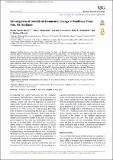Investigation of coastal environmental change at Ruddons Point, Fife, southeast Scotland
Date
30/11/2022Metadata
Show full item recordAbstract
Ruddons Point, on the Firth of Forth coastline, Scotland, is a laterally extensive terrace of glacial and marine sediment deposits raised above current sea level, situated near to Kincraig Point, a key site that records a series of stepped erosional platforms carved into the local bedrock, interpreted as post Last Glacial Maximum paleoshorelines. The deposits at Ruddons Point continue inland, with exposures of the raised sands and gravels cut by the local river, the Cocklemill Burn. The site provides an opportunity to examine the depositional history through the Late Devensian and Holocene. Geophysical survey aided in interpreting characteristics of subsurface sediments such as the transition between the younger saltmarsh sediments and older underlying sands and clays below, which slope in a northerly direction. A chronology obtained through OSL dating spans from ∼29 ka for sands and clays at an elevation of -0.66 mOD to surface windblown sands at < 300 yrs, at an elevation of 8.45 mOD. A basal peat, dated by radiocarbon dating to the early Holocene at ∼9.2 kThematic collection: This article is part of the Early Career Research collection available at: https://www.lyellcollection.org/cc/SJG-early-career-researchSupplementary material:https://doi.org/10.6084/m9.figshare.c.6080999
Citation
Boyd , S L , Kinnaird , T C , Srivastava , A , Whittaker , J E & Bates , C R 2022 , ' Investigation of coastal environmental change at Ruddons Point, Fife, southeast Scotland ' , Scottish Journal of Geology , vol. 58 , no. 2 , sjg2022-005 . https://doi.org/10.1144/sjg2022-005
Publication
Scottish Journal of Geology
Status
Peer reviewed
ISSN
0036-9276Type
Journal article
Description
This work was supported as part of SLB PhD funding from The School of Earth and Environmental Sciences, The University of St Andrews, with additional funding from the SEES Small Research Grant.Collections
Items in the St Andrews Research Repository are protected by copyright, with all rights reserved, unless otherwise indicated.

